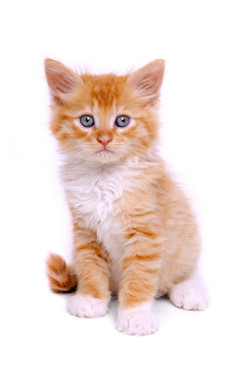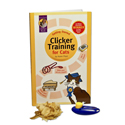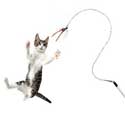Canny cats
From tiny tigers to diminutive panthers, all with entertaining antics and adorable little faces, kittens are one of the great joys of life. But young cats are not just charming; they can be formidable as well.

Despite their fluffy exteriors, house cats come armed with the same weapons as their larger cousins, and with an instinct to hunt and kill. Kittens begin testing their teeth and claws on their siblings, but soon learn to temper their assaults or be left out of the game. Left to their own devices, kittens will grow into cats that are capable of survival on their own without human help. The self-reliance and independence of cats are traits that many cat owners value in their pets. At the same time, owners do not appreciate furniture torn to shreds or children in tears as a result of a kitten playing too roughly.
Because cats are so equipped to look after themselves and provide entertainment and companionship, sometimes it does not occur to cat owners to try to train a cat. In fact, many people believe that cats can't be trained. "Cats do what they like, when they like—and why not?"
However, the things that a cat likes to do may be at odds with the cat owner's view of suitable behavior. Training encourages the cat to change its behavior and become an upstanding feline citizen. Couch potato cats learn to be more active, shy cats learn to come out from under the bed, cantankerous cats learn to be more loveable. Training strengthens the human-animal bond and enriches the lives of both cat and owner. Training is essential for feral kittens that have been living wild without human interaction, if they are to be integrated into a human home.
Clicker training—easy and fun
So, how do we train a kitten? Clicker training is a purrrrfect way to tame a tiny tiger—or even a full-sized one. When the kitten does something good, he gets a click and a treat. (We know that cats will not waste time or energy on anything that does not benefit them!) It is very common for pet owners (and parents too!) to ignore the kitten (child!) when it is not causing trouble, and pay attention to mischief. Wouldn't it make more sense to ignore the undesirable behavior and pay attention when the kitten is doing something adorable?
Karen Pryor tells a story of a kitten who received a click and a treat every time the owner saw it doing something cute. It didn't matter if it was a new behavior or something the kitten had done before. As it grew, this kitten developed a wide range of adorable and entertaining behaviors and was a delight to have around.
Start with kitten tricks
Kittens are very busy with their paws, and this makes it is easy to teach them to give a high five or to wave. Hold a tantalizing toy above the kitten's head, just out of reach, and she will bat at it with a paw. Click as the paw comes up and then let the kitten play with the toy briefly. Again, hold it just out of reach, click when the kitten waves a paw, and let her play once more. Add the cue "wave" just as the kitten is raising her paw. After a few tries, give the wave cue before she starts to lift a paw. In a few training sessions, the kitten will learn to wave on the verbal cue without needing to see the toy dangling above her. Keep the behavior strong by clicking for especially high or fast waves and producing the toy as a reinforcer.
If your kitten is motivated by food, you can give a food treat after the click instead of using the toy as a reinforcer. Kittens love to chase and pounce, so tossing a treat or even a piece of dry cat food after the click adds to the fun. Tossing a toy for the kitten to chase is another reinforcer that you can use after the click. If your kitten is finicky and has trained you to deliver only the tastiest moist cat food, put some in a syringe (without the needle) and give the kitten a tiny taste after each click.
Teach the kitten to follow a target. A jingle ball or ping-pong ball on the end of a chopstick makes a good target. Click/treat when the kitten looks at the target, then when she sniffs or touches it with her nose. Move the target, and click/treat when she starts to follow it. Add the cue "touch" once the kitten has the idea. Soon you will be able to use the target to call the kitten to you, or have her come off the counter, go to her carrier, walk beside you, do other tricks, or run an obstacle course while she follows the target.
Kitten essentials
Jennifer Shryock is an animal behavior consultant and clicker trainer whose favorite training activity is taming feral kittens so that they become social with people and, therefore, adoptable. Jen suggests training the following essential kitten skills:
- accept handling
- soft paws (retract claws when playing with people)
- touch and follow a target
- go into carrier on cue and for sanctuary if frightened (for example, if a fire alarm goes off, the kitten runs for a carrier that is kept near an exit)
Kittens can learn to love their carriers, just the way puppies learn to love their crates. Play a clicker game with the kitten by clicking and giving her a treat when she looks at the carrier, when she takes a step toward it, when she eventually puts one paw in, and then when she adds another paw. Continue until she is going in, waiting for the click, and then coming out to chase the treat. Toss the treats so that the kitten can chase, pounce, and eat. This is tremendous fun for the kitten! Be sure to toss the treats away from the carrier so that the kitten can then race back into the carrier to elicit another click from you.
There are many other ideas for making the cat carrier interesting and enticing. Toss an interesting toy into the carrier for the kitten to chase. Give the kitten her dinner in the carrier. Leave tasty treats in the carrier for the kitten to find. Leave the door open so that the kitten can go in and out at will. Wiggle an enticing toy through the holes in the carrier from the outside, so that the kitten must go in to play with it. Once the kitten is having loads of fun going in and out of the carrier, close the door part way, and then all the way, with the kitten on the outside. Let the kitten figure out how to get in to the carrier to get the toy or treat.
Soon you will have a kitten that loves the carrier and knows how to get into it. Leave the carrier (with a soft bed in it) near an exit. The carrier will become the kitten's sanctuary, and the place she will head to if she gets frightened. This habit may save her life in the event of a fire or evacuation order.
Necessities of life
Every kitten will have to go to the vet for shots, spaying/neutering, and microchipping. Visiting children will almost certainly try to pick up a kitten at one point or another. Teach your kitten to tolerate touch, using the same methods as for carrier training. Click and toss a treat (or dangle a toy for a few moments of play) when the kitten looks in your direction, then when she comes a little closer (and closer), and then when she comes to sniff your hand (if there is a little cat food gravy on your hand this will speed up the process!). Touch the kitten in different ways and on various parts of her body while letting her eat soft cat food from a syringe. Click and toss a treat any time the kitten makes contact or allows longer contact. Handle her feet, look in her eyes, feel her tummy, open her mouth as if you were the vet doing an exam. Click and treat each step to reinforce the kitten for cooperating.
When you play with the kitten, click and treat if she is fairly careful with her claws. Stop the game if she gets too rough. Raise your criteria so that she gets a click and treat (or more play) only when she uses soft paws (no claws at all).
Taming shy or feral kittens
Some kittens don't want anything to do with humans and are fearful or standoffish. These kittens benefit significantly from clicker training because it gives them the control they need to build confidence. Click and toss a treat to a kitten from across the room. Allow the kitten to decide on the next move and click/treat anything that is a little closer to friendly or less fearful behavior. Maybe just looking at you without hissing is worth a click.
Kittens can learn cute tricks like waving, spinning, standing on hind legs, and jumping to a chair without having to come too close. The clicker gives you a way to communicate with the kitten without encroaching on her space. Jennifer Shryock reinforces shy kittens with a click and treat (or play) when she sees them stretching. The stretch is a tension reliever for the kitten and, if reinforced, will be repeated. More stretching means a more relaxed kitten; eventually, the kitten can learn to stretch deliberately in order to calm herself.
Rewards for all
Clicker training will help any kitten gain confidence. The training increases the kitten's trust in you, and she will be more likely to seek out your company. She may even get to the point of snuggling in your lap. If you are involved with kitten rescue or work at a shelter, clicker training cats and kittens to come to the front of the cages and to wave or give a high five makes them instantly more adoptable. Clicker training is easy to teach to new owners, and kittens adjust very quickly in a new home where the owners know how to give familiar cues and reinforce with a click/treat.
The click is non-emotional, clear, precise, and consistent—what a relief for the kitten when she discovers that these new people are just as trainable as the old ones!








super way to train kittes
super way to train kittes !!!!!
I have a new Ragdoll kitten of 2 months, how to tame it?
I like to play without getting bitten by the kitten, please kindly advise, thank you.
How to fix already bad behavior
Ella is about 8 months old and is very playful but she basically does not like to play with anything even her toys or our hands without her claws. I look like a went to war with her. I am not sure how I would be able to reward other things so that she would be gentler. The other issue is scratching the furniture. She has a scratching post but likes my couch better. Please help.
My roommate was thinking about getting a young dog and was interested in this method but how would it work if we are training both the cat and dog in the same house? Please advise.
I'm only just beginning myself, but based on my reading...
Once you have taught her that a click means a treat (or other thing she likes), click and treat her for harmless actions, but never click for unacceptable behaviors. Especially, click and reward her when she is gentle towards people (and remember to click while she's being nice, not after).
Also, be prudent and give her less chances to hurt you. This might help to remove the harmful behaviors from her routine. Like the article says, "Wouldn't it make more sense to ignore the undesirable behavior and pay attention when the kitten is doing something adorable?" Replace the word adorable with non-violent in your case. If she hurts you, don't keep interacting with her, or she will likely be indifferent to her harmful behaviors, or even have them reinforced by your "fun" responses.
With an 8-week old kitten we have, I've been trying crossing my arms and looking away whenever he bites me during petting and rewarding him when he lets me pet him without biting. However, to reduce his tendency to bite, I have also noticed that if I make my fist into a ball, he doesn't bite because my fingers are no longer "chewable". Also, I've discovered that if I pet him about three times, then wait about ten seconds before petting again, he doesn't turn around and bite me. So being observant and practical are important.
Like I said, I'm only beginning and don't have much experience, but hopefully this will help until someone else can give a better answer. I know the answer is a bit late.
clicker and kitten bold to go up to adult cat.
One question ...where can i get a clicker? At a pet store?
Also my tiny kitten is so bold..it scares me. She has not been accepted yet by my two other adult cats, and so I leave her in my bedroom..her "safe" place with her litter food and toys. But she is now wanting out and when i open the door, is escaping. She will walk/ run right up to the adults cats. I am afraid for her with the big cats..any suggestions?
It sounds like, in this case,
It sounds like, in this case, you may want to show the adult cats that the kitten is good to have around, by clicking and treating them for non-agressive behaviors with the kitten present. Remember to never click during aggressive behaviors, though. First, train the cats without the kitten present, so that they learn very well that they want to pay attention to you when you give specific signals. Then, you could try the 'distract and treat' technique. Make a signal noise, and click-treat the cat if it looks away from the kitten, especially for looking at you, and give the reward. When the cat discovers it gets treats for being calm around the kitten, it may more quickly realize, as well, that no harm comes to it when the kitten is around.
As far as the kitten's boldness goes, you might be able to train him to come to you when you give a creatain signal (I'm currently using a double-tap, either with my hand of foot), but this will only work if he's more interested in coming to you than checking out the other cats. I think it is more important to teach the adult cats not to be aggressive.
I'm no expert, so use common sense, and seek better advice if you have any problems.
Several feral kittens in one cage
I love the idea of clicking the kitty for looking at you without hissing! And catching/rewarding the stretch! Question - how does it work with 4 hissy, spitty scared 2 month old feral kittens together in a large cage? How can they differentiate between what one of them did and a click? Do they need to be separated for this to be effective??
Evelyn in Cincinnati
Great idea!
Oh, wow, I love the idea of teaching going to the carrier as a default if frightened. That is brilliant. What a lifesaver, literally!
Laura &
Post new comment